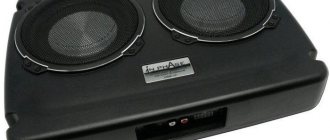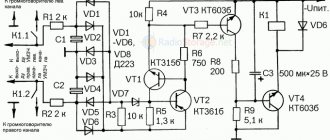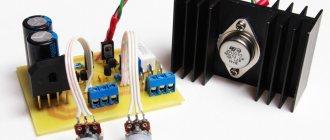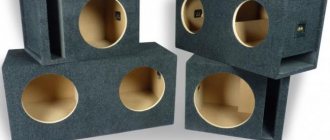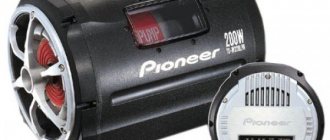Looking for a compact subwoofer for your car? Tired of rattling cheap fakes? Do you dream of a powerful, correct sound, deep soft bass? Maybe you don't want to make the compromises that full-range speaker systems offer? And are you thinking about purchasing separate devices for reproducing high, mid and low frequencies? We bring to your attention a review of the best compact subwoofers for cars.
Each device described below has different dimensions, housing and power to include a full range of space-saving solutions in the car. There are only proven devices that have proven themselves in the market for quality and reliability.
Alpine PWE-V80
pros
- decent sound (minimum nonlinear distortion);
- build quality (nice case material, all elements fit perfectly);
- equipment (in addition to the standard set, there are very long wires for connection: they will reach any place in the cabin; there are even mounting brackets with screws for the body and body);
- in the case - a ready-made solution that does not require creating a sound box or screwing it into the interior frame.
Minuses
- medium-power;
- The bass is harsh, not for everyone.
From 12500 ₽
Active subwoofer. A crossover (a device that separates music into a spectrum of frequencies and supplies speakers with their corresponding frequency characteristics) filters from 50 to 105 Hz. There are a lot of wires in the package, and they are very long. There will be no problems with connecting the power supply. It is connected to the radio through its usual outputs, the amplifier independently cuts off the high frequencies. Maximum power 160 watts. This is quite enough for a medium-sized cabin.
Installation
The subwoofer is installed under the seat strictly according to the manufacturer's instructions. It is placed only horizontally. For installation, use steel guides or an aluminum corner.
Before drilling holes in the floor of the car for fastenings, you should read the instructions for its operation. Some models have a gas tank located under the bottom. Therefore, you need to drill very carefully and use short metal screws.
No manufacturer of a subwoofer under the seat has stated any rules for routing wires. The cable is pulled so that it does not interfere and cannot be accidentally damaged.
Pioneer TS-300D4
pros
- amazing power;
- strength and elegance of design;
- very powerful.
Minuses
- there is no body, which implies additional costs for creating the desired design.
From 3620 ₽
Working 400 watts (maximum crazy 1400 watts) will pump up even a large jeep. The assembly is very high quality and strong. There is no housing, but it can be easily mounted anywhere (depth 147 mm, diameter 300 mm): trunk, door, seat, fender.
Review of Kik ALN 250SA
An excellent device for a reasonable price. Great sound, striking design and ability to perform in extreme conditions make this compact woofer stand out. The subwoofer received a lot of positive reviews and praise from experts.
Peculiarities
- Flat “underseat” sub with a collapsible design;
- Housed in a durable plastic-metal box with high damping;
- The woofer diffuser is made of pure aluminum;
- It is distinguished by a collapsible body design, which is firmly fixed with tightening bolts;
- The manufacturer took care in advance to ensure that the installation was reliable and simple;
- Kik subwoofers are very compact;
- Speaker size – 10 inches;
- The installation of the Kik speaker by the manufacturer is carried out not only in the acoustic design of the ZI, but also in installations such as Stel;
- The speakers have a low and dense quality factor, providing ideal bass;
- Excellent protection against overheating, short circuits and various overloads.
Installing compact “underseat” or “luggage” subwoofers is easy, even without outside help, with your own hands. Only during the process you need to study the instructions, watch the video review and photo materials.
Looking for a compact subwoofer for your car? Tired of rattling cheap fakes? Do you dream of a powerful, correct sound, deep soft bass? Maybe you don't want to make the compromises that full-range speaker systems offer? And are you thinking about purchasing separate devices for reproducing high, mid and low frequencies? We bring to your attention a review of the best compact subwoofers for cars.
Each device described below has different dimensions, housing and power to include a full range of space-saving solutions in the car. There are only proven devices that have proven themselves in the market for quality and reliability.
Hertz DS 30.3
pros
- the softest, deepest bass;
- excellent design: the device looks futuristic, but not pretentious;
- the size of the range of reproduced frequencies, that same infrasound is present;
- high-quality materials, special attention is paid to their ability to dampen parasitic vibrations.
Minuses
- there is no body, which implies additional costs for creating the desired design.
From 5610 ₽
The Italians from Elettromedia admire the design. Externally, a very expressive car sub. The diffuser holder is rubberized. In general, everything that can create rattling is “drenched” with damping material, a noise-attenuating structure.
Like all compact subwoofers for cars without a “house,” this one is in dire need of it. The best volume for it is about 20–30 liters, preferably with a spacious bass reflex. By the way, you can assemble a speaker structure in any form factor: flat, square, trapezoidal. This will allow for the most optimal placement of the device itself. Good sensitivity. Nonlinear distortions are minimal. Very wide frequency range (28 - 300 Hz).
Review of Ground Zero GZUB 1000XACT
Active subwoofer in car
Flat type woofer, easy to fit under the seat. The sound quality is good, but the price is a little surprising - 17 thousand rubles!
Peculiarities
- Power (at peaks) – 210 W;
- Power (nominal) – 150 W;
- Operating frequency range – 30-100 Hz;
- LF crossover frequency range – 50-100 Hz;
- Signal to noise ratio – 60 dB;
- Speaker size – 10 inches;
- There is a high-level input with automatic activation;
- Aluminum diffuser;
- There are RCA inputs.
Ural AS-D12A Slim Hurricane
pros
- miniature, thin;
- speaker sensitivity 93 dB;
- in the body - a ready-made solution that does not require the creation of a sound box or insertion into the car body.
Minuses
- medium-power (I would like better sound quality in the lower range, this is due to the small size of the device).
From 8141 ₽
Small compact subwoofer. A sound machine with a bass reflex, which is a delight not only for fans of pop and rock music, but also for fans of drum & bass and rap. Both speakers are large, 16 centimeters in diameter. Rated power of 100 watts will fill any salon. The lows will increase noticeably, but don’t expect any rattling of the glass. A big plus is the mosfet amplifier, which does not mind overheating, is not afraid of breakdown and provides excellent sound quality (low and high frequencies are especially good). All this is packed into a thin oblong case.
Compact active subwoofers
Measurements: Yuriy EVTUSHENKO
The media career of any type of car audio equipment goes through several stages. The first is news. Like: “Wow, what did they come up with!”
Velas VSA-8.0F | Ground Zero GZTB 200XACT | Pioneer TS-WX110A | Focal IBUS 20 | Rockford Fosgate JPS-100-8 | Kicker Hide Away HS 8
The second stage is a one-on-one acquaintance in the “On the carpet!” section. Here the answer to the question “what you really are” is sought (and found). As a technology category matures and takes root in the industry, the conditions for a group test arise. Here it becomes clear how each of those who came to the tests does what they were invented for. On a common basis and under the same conditions.
Leaving the stage (and this also happens, although not for everyone) is arranged much less solemnly. Once upon a time we had group tests of radio tape recorders in the true meaning of the word, that is, with a cassette. A cassette, kids, is like the case you bought for your iPhone for fun, only smaller. There were group tests of CD changers, at the same time, video devices appeared on the carpet for the first time, which today are for group testing - just whistle, and so on. Nowadays, in our opinion, compact subwoofers have entered the category that has matured and taken root.
But first, let’s define the classification - since when did compactness itself become a species-forming characteristic? On its own - no, it didn’t. However, the fact that dialectics was deleted from the curriculum does not cancel it; the transition from quantity to quality works under any government composition.
What is usually the volume (in this case, external) of a typical, normal subwoofer, be it a finished product or the materialization of the calculated characteristics that we accompany any test of subwoofer heads? This is how it goes... It happens that there are 90 - 100 liters, in practice this means: hello hot to the trunk, potatoes - only in small packaging, children - only carry them in your arms. The most popular volume, from 30 to 60 liters, is already more humane in relation to the family. When it turns out that the bass instrument fits into a volume of 15 - 20 liters (or sometimes it was 10 - 12), it can be hidden in a completely secluded corner. But a corner of what? Yes, still the trunk.
And only when the volume of the case in liters (again external) becomes a single-digit number, it turns out that there is nothing left for the subwoofer to do in the trunk. Not because it’s impossible, but because such unoccupied space exists in the cabin. Under any of the front seats.
Hence, not only the dimensions, but also, as they say now, the “form factor” of subwoofers of this type. Nobody really needs a super-compact subwoofer in the form of a cube or a barrel; it will still get in the way in the trunk, and there’s nothing else you can do about it. But if you make the case flat, like a typical amplifier, then the trick is in the bag. Or rather, on the contrary, as far as possible from the hat, under the seat.
And when the form is determined, it itself begins to dictate the content, including the physics and chemistry of the process. Firstly, the housings of such subwoofers are usually cast from an aluminum-magnesium alloy. Everything is simple with this: with a body height of 7 - 8 cm, using MDF, the walls would account for 3 - 4, roughly speaking, half. Secondly, the design of the enclosures provides for their installation on a plane with the head pointing upward, and not horizontally or at a slight angle, like “adult” subwoofers, so today we give the dimensions not by the enclosure (as usual), but by the protruding protection heads - in this case this is significant. However, the height of the body does not differ much - 78 mm for the highest and 70 mm for the most “low-profile” participant, and other dimensions for the majority are similar - which, if you look at it, is natural: the dimensions of the seat in cars are determined not by the size and class of the car, but in size... how should I say... in general, they are about the same. There was still an exception, to a lesser extent.
Most often, “under-seat” subwoofers use 8-inch heads made in a slim design, otherwise how would they fit into a body of such thickness, although designs with heads of sizes 250 and 165 mm are known. I think it’s clear that you shouldn’t expect from heads of this caliber: a) serious sound pressure and b) low nonlinearities. Of course, a lot depends on the design of the heads, but the spread of indicators within the group does not negate the general patterns. In particular, the majority of classmates have a maximum sound pressure below 100 dB (for some it is much lower).
This is the time to explain: we, as usual, measured the maximum sound pressure in laboratory conditions, emulating free-field conditions, just as we do for large case-mounted units. Inside the car, the pressure will be higher in both cases, but the comparability of the results is important here. For “adult” subwoofers, we recently decided to use a signal with a frequency of 56 Hz to measure maximum SPL, for compact subwoofers we decided to return to 63 Hz, so as not to torment the fragile souls of children. To the same point and for essentially the same reason, we increased the lower limit of the SOI measurement range. The measurements were carried out at a sound pressure of 93 dB, and not 96 dB, as for “regular” subwoofers. The logic here is this: front acoustics will create the same 93 dB, provided that each channel operates at a pressure of 90 dB (at which we measure nonlinearities in broadband acoustics).
I think you already understand: the average compact subwoofer cannot play very loudly and cannot be free from non-linearities. All he can do is provide support for the fronts in the mid-bass, while taking up virtually no space in the car. This is what concerns mainly the amount of bass. What about the quality?
Let's start with the fact that in one respect, seatposts have an advantage over serious luggage subwoofers. You probably already guessed from the keywords: the problem of bass localization is significantly reduced here, the source of the bass is right below you, and the cutoff frequency of the subwoofer low-pass filter can be selected based on auditory sensations, within wider limits, “until readiness”, as written in culinary recipes. Please note: I wrote “cutoff frequency” and not “section frequency”, as I usually do; in many cases, especially when using a standard head unit, there may not be a second filter (front high-pass filter).
Is an ultra-compact subwoofer capable of reproducing bass with impeccable accuracy (even without infrasound)? Let's figure it out. According to our statistics, the average equivalent volume for a 200 mm head is about 16 liters. Even if we take an extremely low (for a “flat” head) total quality factor Qts = 0.5, then in a box with a volume of 3 - 5 liters the resulting quality factor will be about one, which means that an overshoot of two decibels or so is inevitable in the frequency response. This in itself is not a disaster, but to what extent the participants will correspond to such a theoretical structure, we will soon find out.
In my opinion, compact subwoofers can show themselves in a more favorable light in the interiors of small cars. One can even assume that these subwoofers are primarily aimed at the interiors of cars of classes B or C, which, in general, is logical - in a large car it is easier to find a place for a “normal” subwoofer. In any case, during measurements in a Citroen (class D), the decline in frequency response at the bottom pushed precisely to this conclusion.
Regarding the type of design of compact subwoofers, the situation is simple: ZY and only ZY. Why? Well, let's start with the fact that with the same lower frequency limit (in the cabin), the FI box turns out to be more voluminous than the ZYa, but this is not the main thing. Estimate what length even a 7-8 cm pipe should have in order to get a 40 Hz setting for a volume of even 5 liters. And also figure out where to place it under the seat. In theory, you can try a PI (passive emitter), but so far no such attempts have been seen.
Under-seat “super compacts” by definition fall into the category of active subwoofers. It would be strange to make a subwoofer the size of an amplifier, and then connect it to an amplifier the size of... the amplifier. The built-in amplifier in most cases is pulsed; all its advantages (low power consumption, dimensions and heat dissipation) “under the saddle” are in demand like nowhere else. I remember that a couple of years ago it was unprofitable to make amplifiers with a power of 100 - 150 W in class D, but now the technologies are fully debugged, and the situation has changed. However, a class AB amplifier (especially if it is made on a microcircuit) is still cheaper, and at least one (the first and most affordable) of the participants, according to some features, is equipped with an “analog” amplifier.
In terms of equipment, underseat subwoofers are not much different from their “adult” relatives. Except that products without a bass regulator are more common among them than among “large” active subwoofers, which is understandable: this is not the unit that needs boosting, and certainly not the one that can handle it. At the same time, high-level inputs are the norm here, since it is known in advance: in the target group there are many who do not intend to change anything else in the standard system, and these often do not have linear outputs. All participants in today's group were equipped with a remote regulator; we consider its presence to be the norm, implying by default that such a regulator controls the output level, that is, it is a tunable attenuator. And this (apart from high-level inputs) is one of the few defaults in today's test. To these I will also add the body material; there is no reason to repeat every time that it is cast from an aluminum alloy. This also includes the linear inputs - there are two of them, and the signal from them is summed, so if you use only one of them, the sensitivity (and gain) will be halved. Well, now - on to the horses. I mean, on the saddles... Well, you understand...
Focal entered the “Leaders” with a score of 41 points. It should be noted that the subwoofer is successful, but in terms of the value of nonlinearity it was frankly surprising; “seat-mounts” have natural problems with this, but Focal somehow avoided them. Or he decided that it doesn’t matter to us. The closest pursuer of the Frenchman is Ground Zero, in a number of characteristics it was inferior to the winner, but in terms of the tonal balance of the bass it has no competitors in the current group, and the title of “Favorite” is the least we can get from Pioneer for its truly fantastic compactness, and if this had an effect on the maximum sound pressure (it could not help but have an effect), but the frequency response in the cabin is practically non-existent, it is “like big ones.”
Tags: Group test
Sony HT-CT390
When watching your favorite movie, you can feel yourself at the epicenter of the sound stage thanks to this soundbar. The developers paid special attention to two speakers that have the ability to reproduce balanced sound over the entire frequency range. The built-in Sony wireless subwoofer provided a richer bass sound - a dynamic movie scene or any special effect is perceived as realistically as possible.
Wireless streaming of audio and favorite tracks is possible from various applications via Bluetooth with almost any smartphone or tablet.
Features: easy connection Bluetooth 4.0, three universal settings modes - movie, 3D and news, after 10 minutes of inactivity, switches to standby mode, ability to mount on a wall, 3D surround sound effect.
PolkAudioSignaS1 Soundbar
With the soundbar body measuring 89 x 5 cm, it can easily block the IR receiver located on the front panel of the TV if it is installed in front of it on one shelf.
The front panel of the system is covered with fabric, behind which two 1-inch tweeters and two woofers with a diameter of 4.4 inches are hidden. At the top of the speaker body there are control buttons for pairing a wireless subwoofer via Bluetooth, adjusting the volume and switching inputs. The included remote control is quite ergonomic; it’s easy to switch inputs and control all functions. Other characteristics:
- Connectors and interfaces - Bluetooth, digital optical input, Wi-Fi, AUX.
- The total sound power is 200 W.
- Special features: Dolby Digital decoder, VoiceAdjust technology, wireless subwoofer.
- Delivery set: soundbar, subwoofer, documentation, control panel.
Onkyo LS7200 system
An elegant low-profile soundbar with a wireless subwoofer, a large bass speaker, and an elegant AV receiver HT-L05 will be a great gift for all those who like to thoroughly upgrade the sound of their TV.
The system receiver is equipped with effective wireless technologies: from advanced DTS Play-Fi and Bluetooth version 4 to AirPlay and dual-band Wi-Fi, which allows you to combine all network audio available for connection in one interface application:
- web radio;
- streaming services;
- local network files.
The Onkyo LS7200 has four HDMI inputs and HDMI outputs with a return channel, allowing you to receive audio directly from your TV. The entire device can be controlled either from the standard remote control or through the Onkyo Controller smartphone application.
Peculiarities:
- support for Bluetooth, Wi-Fi, AirPlay, FireConnect and DTS Play-Fi functions;
- connection to the receiver via a single cable and a separate wireless subwoofer;
- eight-speaker soundbar;
- AccuEQ auto calibration, 4 X HDMI.
Music
The next point when choosing is the nature of the music for which you are choosing a subwoofer. It must be said right away that the opinion that a large sub will be slower or the bass will be fatter is a common misconception. This will be influenced more by the design and connection to the amplifier than by the size of the sub.
But the general rule is that the lower the setting, the more the speaker works here. Buy one large subwoofer if you listen to low tracks and opt for a smaller pair if you want versatility or higher tuning. This is related to the resonant frequency (Fs), since for larger ones it is usually lower.
There is also one nuance related to the size of the diffuser. At higher settings, due to the fast movement and large diameter, the edge of the diffuser will lag slightly behind due to natural deformation. And the faster its movement, the more distortion will occur, and accordingly, not the entire area will work. Of course, this is a rather microscopic nuance in these modes and it very much depends on the materials. Here's a little bit, but let's repeat - this is not about group delays and bass depth.
